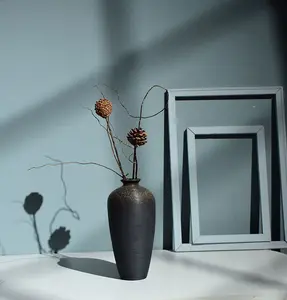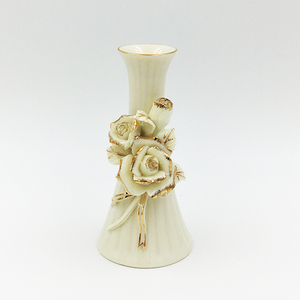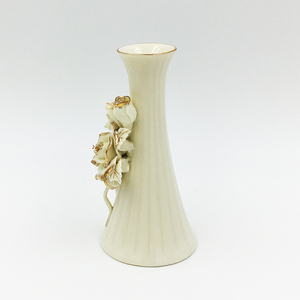(162859 products available)






































































































 Ready to Ship
Ready to Ship

















































































 Ready to Ship
Ready to Ship























Chinese vases have a long history. They reflect Chinese culture and art. Different types of Chinese vases show varied styles and traditions.
Porcelain vases from China:
Chinese porcelain vases are made of kaolin clay, which is pure white and fine. It is fired at a very high temperature. The result is a strong and translucent body. The glaze is usually glass-like, clear, and shiny. It can show the colors and designs underneath. Porcelain vases are durable. They are treasured for their beauty and elegance. They often have intricate hand-painted designs. These include traditional blue-and-white patterns. They also have bright colored scenes. They are popular in China and worldwide.
Jade vases from China:
Jade vases are special items in Chinese culture. They are made from jade, a green stone that represents purity and goodness in China. Artisans spend a lot of time polishing jade to make it shine. These vases are usually simple but show the stone's beauty. Jade has a smooth feel and solid texture. It makes these vases valuable and meaningful. People think they bring good luck and health. That's why jade vases are highly valued and given as gifts in China.
Glass vases from China:
Chinese glass vases have a long history. They grew in popularity during the Qing dynasty. Artisans made them from glass and added many colors to them. Some well-known kinds are cinnabar, cloisonné, and crystal glass vases. Cinnabar vases use a red, thick glaze. It is called cinnabar. It is named after the mercury sulfide mineral. Cloisonné vases have designs made with copper wires. These wires form separate spaces filled with enamel. Crystal glass vases have intricate designs. They use cutting and polishing techniques to make them stand clear and shine. All these glass vases show the skill of ancient Chinese glassmakers.
Metal vases from China:
In ancient China, artisans made metal vases. They used precious metals like gold, silver, bronze, and copper. These vases were often used for important ceremonies or as valuable gifts. They showed the owner's wealth and power. The metal vases were decorated with intricate patterns. They included scenes from nature, animals, and mythological figures. Skilled craftsmen used techniques like engraving and inlaying to make the designs. Bronze vases were especially important in ancient Chinese rituals and ancestor worship. All metal vases showed the high status of their owners and showed Chinese culture.
Chinese vases are designed with intricate details. Some design elements include:
Shapes and Forms:
Different vase shapes have been made throughout history. For example, the Ming dynasty saw the creation of blue and white vases with bulbous forms. These vases had wide bottoms that tapered to narrow necks. They were called "onion vases" due to their bulbous shapes. The Qing dynasty also saw the production of vases with intricate cloisonné enamel work. These vases had tall, slender shapes with flared mouths.
Motifs and Patterns:
Chinese vases feature many motifs and patterns. Floral motifs are common on vases from the Ming and Qing dynasties. For example, peony vases have images of peony flowers, which symbolize wealth and prosperity. Dragon motifs are also common on vases. They represent power, strength, and good luck. Vases from the Ming and Qing dynasties have dragon designs. They are often used as imperial gifts or displayed in palaces.
Materials and Techniques:
Chinese vases use high-quality materials. They reflect the craftsmanship of their makers. Porcelain vases from the Ming and Qing dynasties were made using fine, translucent porcelain clay. The clay was carefully selected for its quality. It was fired at a very high temperature to make a strong, glass-like body. Cloisonné vases were made using copper wire and enamel. The wires formed shapes, and the enamel was colored to fill them.
Cultural Significance:
Chinese vases have great cultural significance. They show social status and wealth. The more intricate the design and the finer the materials, the more valuable the vase. Vases were also used in important ceremonies. They showed the refinement and artistry of Chinese culture.
Overall, the designs of Chinese vases made during different dynasties show the skill and artistry of their creators. The intricate patterns and high-quality materials used to make these vases reflect their cultural importance and the craftsmanship of their makers. Chinese vases have become treasured collectibles that show the history and artistry of China.
Home Decor:
Decorative vases are used in homes to make pretty displays. They hold flowers or stand alone. People put them on tables, shelves, or fireplaces to make the room look nicer. They come in different styles, like modern or vintage, to match the home's look.
Office Decor:
Placing elegant vases in offices makes the space look more professional and welcoming. They are often put on desks, in reception areas, or in conference rooms. A vase with fresh or artificial flowers can make a big difference in how the office looks and feels.
Art Galleries and Museums:
Art galleries and museums may show special vases as part of their exhibits. These places show vases that are rare or have historical value. Visitors can learn about the vase designs and the time and culture they come from.
Hotels and Restaurants:
In hotels and restaurants, vases make the space look nicer and more inviting for guests. They are often on tables, in lobbies, or in other common areas. A beautiful vase can make a big impact on the dining or staying experience.
Event Decor:
Vases are used to decorate events like weddings, parties, or corporate functions. They hold floral centerpieces or contribute to the overall theme. Depending on the event, the vases may have a formal, whimsical, or rustic look.
Film and Television Sets:
Prop vases are used in movies and TV shows to make sets look realistic. They help create the right look for different periods and places. Using vases makes movie and TV scenes seem more believable.
Educational Purposes:
Vases are used in schools and training centers to teach about art, history, and culture. Students learn about different vase styles and the significance of the societies that made them. Learning with real vases helps students understand better.
Gardens and Outdoor Spaces:
Vases can also be used outside, like in gardens or patios. They may hold plants, flowers, or just be decorative. Outdoor vases often have tougher designs to handle being outside.
Purpose:
When choosing a vase, the first thing to consider is the reason for getting it. Is it to decorate a room, show off some flowers, or as a valuable gift? If it is for decoration, a pretty vase with bright colors or patterns can be chosen. If it is to hold flowers, then a more functional one that is wide at the top so the flowers can fit in well would be better. For a valuable gift, opting for a more unique vase with intricate hand-painted designs would be ideal.
Style:
Chinese vases come in many different looks from old times to modern ones. Traditional styles include Ming, Qing, Cloisonné, and Yixing. The Ming style is known for its simple, clean shapes and blue-and-white paintings. Qing style features intricate, colorful designs. Cloisonné has metal wires creating patterns filled with enamel. Yixing vases have rustic pottery suited for informal tea gatherings. Users should look closely at the shapes and decorations on vases to find one that matches their taste before purchasing. Consider whether one prefers the classic looks or thinks modern styles with new colors and materials are more exciting.
Materials:
Chinese vases are made from various materials, each with unique qualities. Porcelain vases are very white and shiny and suitable for detailed paintings. Pottery vases made from clay have a rustic, homey feel. Cloisonné vases are metal with colorful enamel designs. Glass vases can show off creative patterns and shapes. The material affects the vase's look and how delicate or durable it is. Glass, Cloisonné, and Yixing vases will be more resilient than fragile porcelain or pottery ones, which need more careful handling. Users should think about what material suits their style while considering how easily each type breaks.
Size and Shape:
The size and shape of a vase are very important for its use and appearance. Tall, narrow vases are good for small flower bunches, while short, wide ones suit larger arrangements. Users should match the opening at the top of the vase to the size of the flower bunch they wish to put inside. Large vases also make a more impressive floor display compared to small ones better suited for tables. Shapes like straight columns, round bulbs, or slender necks each suit different styles of flowers or decorative looks. Considering what type of flowers will be used and where the vase will be placed helps select the best size and shape.
Q1: How to identify a Chinese vase?
A1: Look at the base. Chinese vases usually have a double happiness symbol. They also have marks from the artist who made them. Check the colors. Chinese vases have bright, bold colors. Chinese vases show scenes from history, birds, flowers, and dragons. Older vases have finer, thinner cracks in the glaze. The cracks are a sign of age. Chinese vases are made of porcelain clay, which is very white and smooth. If it feels rough or heavy, it may not be Chinese. Authentic Chinese vases will be lighter than they appear.
Q2: Are Chinese vases antique?
A2: Chinese vases come in three main types: porcelain, clay, and glass. Porcelain vases are usually made in China. Clay vases can be Chinese but are also made in many other countries. Glass vases are made in China but are not antiques. To tell if a vase is an antique Chinese one, check for: 1. Age - Antiques are usually over 100 years old. 2. Signs of aging - Older porcelain vases have finer, thinner cracks in the glaze. 3. Materials - Authentic old Chinese vases use very white and smooth porcelain or fine clay. 4. Family history - Documents showing who owned the vase for many years helps prove its age and authenticity. A history of ownership is important for antiques but less so for just identifying old Chinese vases. Use several clues about age, materials, and ownership records together to determine if a vase is an antique Chinese vase or just an old one.
Q3: How can we take care of Chinese vases?
A3: To take care of Chinese vases: 1. Clean them gently. Use a soft cloth or feather duster. Don't use harsh cleaners. 2. Don't put them in the dishwasher or microwave. The heat can damage them. 3. Keep them out of direct sunlight. Sunlight can fade their colors. 4. Don't expose them to extreme temperature changes. It can cause cracking. 5. Use museum putty to secure them if they are valuable and tip-over prone. It helps prevent accidents. 6. Handle them carefully. Always hold them by the base. The top can be fragile. 7. Store valuable vases in a display cabinet. It protects them from dust and handling.